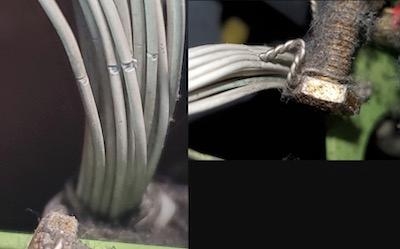Incident Occurred November 6, 2019
Based on preliminary findings from its ongoing investigation of an incident involving an Embraer-175 airplane, the NTSB issued has 10 safety recommendations to address safety issues identified in the investigation.

The NTSB issued six safety recommendations to the National Civil Aviation Agency of Brazil (ANAC) and four to the FAA. The recommendations are designed to address areas of concern including wire chafing, application of Embraer service bulletins relating to the pitch trim switch, and potential limitations in checklist memory items for pilots to address unintended operation of the pitch trim system.
The investigation and recommendations stem from a Nov. 6, 2019, incident involving Republic Airways flight 4439, an Embraer EMB-175. The flight crew declared an emergency shortly after takeoff from Hartsfield-Jackson Atlanta International Airport, Atlanta, reporting a pitch trim-related flight control issue and difficulty controlling the airplane. There were six passengers on board the airplane. The crew returned to the airport and safely landed the plane about 15 minutes after declaring the emergency.
Although the cause of the incident remains under investigation, post-incident examination of the airplane revealed chafed insulation around wires connecting the horizontal stabilizer actuator control electronics to the captain’s pitch trim switch and autopilot/trim disconnect button. The chafing was caused by contact with the incorrectly untucked pigtail of the forward mechanical stop bolt safety wire.
When the captain’s pitch trim switch was removed from the yoke, marks were observed that indicated at some point before the incident flight, the pitch trim switch had been installed in an inverted position. Embraer previously issued three service bulletins related to pitch trim switch installation error following reports from flight crews in 2015 about flight control system difficulties. However, neither the FAA nor the ANAC required incorporation of the service bulletins. While it is not yet known if inverted switch installation was a factor in the incident, the NTSB is concerned the condition could lead to flight crew confusion, delaying appropriate recognition of and response to increased control forces.
Preliminary information from the NTSB’s investigation also suggests that unintended pitch trim operation may be masked and go undetected during certain phases of flight, such as during takeoff. Further, limitations in the checklist memory items may delay pilots in properly responding to and regaining control of the Embraer EMB-170/175/190/195 and Lineage 1000 series airplanes. The NTSB is concerned the crew’s application of the memory item(s) on the EMB-175 Pitch Trim Runaway checklist may not comprehensively address circumstances of the trim system operation in a timely manner.
Based on these preliminary findings from the ongoing investigation, the NTSB issued the 10 safety recommendations to address these safety issues.
“Issuing these 10 safety recommendations early in the investigation demonstrates the NTSB’s commitment to take action as soon as we’ve identified and verified a safety issue that needs to be addressed,” said NTSB Chairman Robert Sumwalt. “We don’t need to wait for an investigation to be completed before issuing safety recommendations. We have the responsibility to issue recommendations that when implemented by recipients, can correct safety deficiencies, prevent accidents, and save lives.”
Aviation Safety Recommendation Report 20-01 is available at the FMI link below.
The NTSB’s investigation of the Nov. 6, 2019, incident is ongoing and as such, no conclusions about probable cause should be drawn from the information provided in the safety recommendation report.
(Image provided with NTSB news release)
 Airborne-Flight Training 05.09.24: ERAU at AIAA, LIFT Diamond Buy, Epic A&P
Airborne-Flight Training 05.09.24: ERAU at AIAA, LIFT Diamond Buy, Epic A&P ANN's Daily Aero-Term (05.07.24): Hazardous Weather Information
ANN's Daily Aero-Term (05.07.24): Hazardous Weather Information Aero-News: Quote of the Day (05.07.24)
Aero-News: Quote of the Day (05.07.24) NTSB Final Report: Cessna 150
NTSB Final Report: Cessna 150 Aero-News: Quote of the Day (05.08.24)
Aero-News: Quote of the Day (05.08.24)



